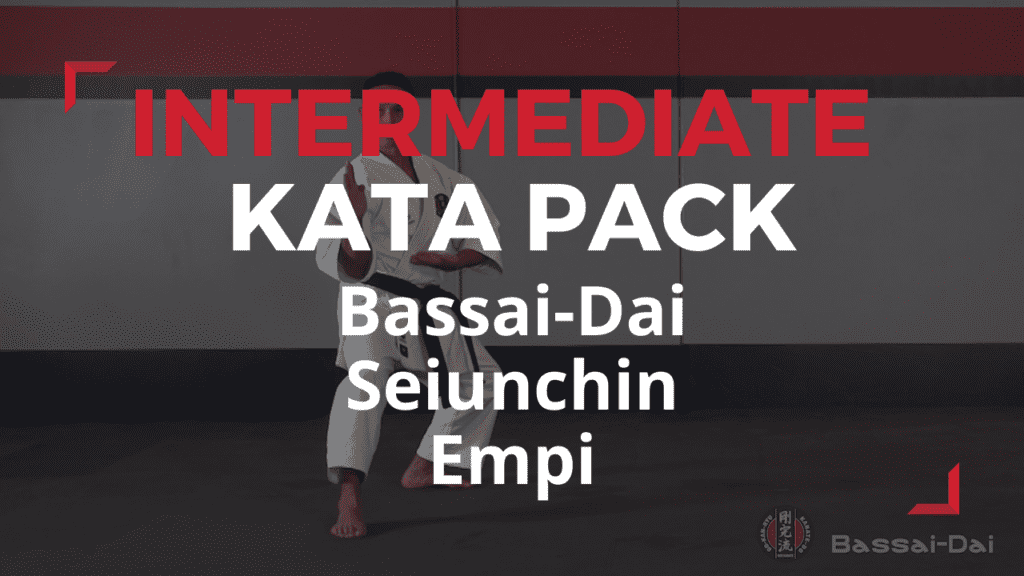- Home
- Kata Seiunchin
-
INTRODUCTION TO KATA SEIUNCHIN
At Brown belt level you will be introduced to kata Seunchin. This kata has a number of similarities and differences between the previous kata to date.
Similar to Taigyoku Shodan and Nidan, this kata focuses mostly on remaining in deep, well grounded stances throughout combat. As it focuses on combat from a much closer range it does not implement the explosive, long range techniques. Nor does it focus on Ikken Hisatsu (one strike finish).
Similar to Saifa, this kata is consistently ebbs and flows between the hard and soft aspects of karate. Like Saifa, it implements fluent, circular movements in offensive and defensive techniques. And like Saifa, it often deals with escaping an attackers grip (from both the front and the rear), and tries to get behind an opponent to avoid toe-to-toe combat.
It differs by the fact that, where Saifa deals with tearing ones-self free from an attacker’s grip and counter striking (Sai = smash and Fa = tear), Seiunchin’s principles often deal with the attacker whilst they still have a grip on us. Seiunchin translates as ‘to grab and pull in battle’.
Seiunchin’s combat range is closer than Saifa’s as it often deals with an attacker who can reach completely around you.
Similar to Bassai-dai, the kata aims to avoid toe-to-toe combat by turning our attacker on their axis (rather than the defender moving themselves). And like Bassai-dai, it regularly achieves this by blocking a single strike or grab with both arms blocking in the same direction one after the other (ren uke). Note however that the ren uke in this kata are more subtle.
Seiunchin differs greatly to all previous kata in appearance by attacking and defending on angles. All previous kata follow the four basic embusen (line of movements), which are North, South, East or West. Seiunchin by contrast uses eight embusen (8 angles of movement).
-
STANCES IN SEIUNCHIN
Seiunchin commonly uses three basic stances, Sumo (shiko dachi), Pigeon Toe (Sanchin dachi) and Cat (neko ashi datchi).
It also introduces a student to a parallel stance (Heiko-Sanchin). Heiko-sanchin dachi is very similar to Sanchin dachi (in length and width) however the front foot is parallel to the back foot (similar to Heiko dachi)
-
STRIKES IN SEIUNCHIN
Seiunchin’s most commonly used strikes are Back-fists (ura uchi), Hammer-fists to the groin (gedan tettsui) and the Vertical fist punch or Uppercut (tate tsuki).
-
SEIUNCHIN HOME PRACTICE
The journey of Seiunchin should be to first develop all the right technical aspects, making sure you dot all the I’s and cross all the T’s. There is no point being fast or explosive if you have poor technical habits as these will not serve you well in self-defence.
The best way to achieve this is to practise at home often (you might also practise before and after class). When you practise, go through the kata in super slow motion. Going through in super slow motion enables you to really think about each and every aspect of each movement. This allows you to perform it correctly, creating muscle memory and positive habits. It also allows you to identify poor habits (and correct them), habits that you may not have identified at regular pace. Going at this pace also means you wont pull any muscles or work up a sweat (so you can even practise in at work in your office).
Once you have practised it a few times in super slow motion, build it up to medium pace and then finally at regular pace.
-
SEIUNCHIN HISTORY
Seiunchin was chosen to specifically follow Bassai-dai in the GKR kata system. Students train in Bassai-dai over two belt grades and this kata concentrates on power developed through dynamic, straight-line speed. While this is an essential component to achieving effective karate, it is still only a small part of what karate represents. Seiunchin is one of the most famous kata in karate, part due to its uniqueness and beauty. So having trained with the explosive Bassai-dai for some time, arriving at 3rd kyu brown belt, it is important students develop a sense of fluency, beauty and strength within their kata.
While Bassai-dai trains students to develop snapping techniques and to be quick to move, Seiunchin develops its power by utilizing low shiko datchi (sumo stances) and circular movements to block or grapple. It is also more concerned with being ‘rooted’ instead of agile (hence its absence of kicking techniques). Its timing is completely different from all previous kata and so, too, its use of angles, introducing a number attacks and defenses on 45 degree angles.
Like many of the traditional kata, the origins of Seiunchin are steeped in mystery. Some believe it was introduced to Okinawa by Kanryo Higaonna after he returned from studying in the Fukian Province of China. Other equally reputable sources state that it was developed in 1920 by one of Kanryo’s students, Chojun Miyagi (founder of Goju-Ryu), and was possibly formulated after Miyagi spent a year in China studying Pa Kua Ch’ang Kung Fu (one of Kung-fu’s three internal styles). Miyagi developed the style of Goju by combining his studies of Okinawan Naha-te with his training from China.
Regardless of who developed this kata, its Chinese influences are apparent, as are its Naha-te based origins, because it contains the deep tension breathing common in that style. All of which results in a kata of power and beauty.
As there is no true literal translation from kanji, Seiunchin is mostly translated one of two ways. The first is, “the calm in the storm”, which is an appropriate translation when we take into account the timing of the kata. The second, and more likely correct translation is “to grab and pull in battle”. This is a translation apparent to its bunkai, which consists of numerous grabs, pulls, throws and locks. There is probably no other kata that better demonstrates traditional karate.
Seiunchin (whose creation was most likely influenced heavily by one of China’s three internal kung-fu styles) is very much an internal karate kata. The following paragraph offers a simplistic explanation of the term ‘internal’ versus ‘external’. In post war practice of karate, the emphasis on training predominately shifted to ‘external’ training. ‘External’ or ‘hard’ related to the development of power through body strength (ie. building stronger arms and legs). The ‘internal’ or ‘soft’ however concentrates on the whole mind/body merging together to create power (often using the energy of the opponent to receive, defend and attack with flowing counters). Additionally, Seiunchin incorporates numerous movements executed slowly with strength (but not over tension) and contains a lot of abdominal breathing (which controls blood flow and circulation).
Seiunchin’s combat philosophy concerns itself with equipping a practitioner to face a larger, stronger opponent who is constantly grabbing. You will note that during this kata, the emphasis is on being grounded and powerful. There is an absence of kicks (to prevent being off-balanced by a larger opponent); blocks are circular (to develop strength required to combat a larger opponent’s grabs and kicks) and it uses a unique version of multiple attacks. Most kata use separate limbs to execute multiple attacks (such as a kick then punch or one arm attack then the other), Seiunchin in contrast involves the ‘crane technique of vibration’ which involves delivering a multiple of attacks in the same action (such as the uppercut, back-fist then groin strike, or elbow then back-fist strike all done with the same arm). The crane technique of vibration theorized that by executing multiple attacks with one arm (and avoiding squaring the body off to a larger opponent), it is more difficult for this opponent to grab or seize you. Furthermore, in the event of being grabbed or seized, the entire body was not committed to the technique, therefore one arm was still free to deliver a decisive blow.
-
SEIUNCHIN LINEAGE TO GKR
Kanryo Higaonna (1853-1915)
Possibly developed the kata after training in China for 13 years and taught it to Miyagi.
Chogun Miyagi (1888-1953)
It was most likely the founder of Goju, Miyagi developed the kata after studying one of the three internal styles of Kung-fu.
Gogen Yamaguchi (1909-1989)
Gogen Yamaguchi was already a reputable karate-ka of Goju before he met its founder (Chogun Miyagi) around 1930. Miyagi became so impressed with Yamaguchi that he made him his successor for Goju in Japan.
GKR Karate
While also all styles hailing from Naha practise Seiunchin, GKR derives its version from Japanese Goju (not the more kung-fu appearing Okinawan Goju Seiunchin).
Practice and perfect Seiunchin at home with the ‘Intermediate Kata Pack’.
This pack includes Bassai-Dai, Seiunchin and Empi, with 2 separate sections for each kata –
Kata performed to the count and Technique breakdown of the Kata.
CLICK HERE to head to our online store to purchase.




